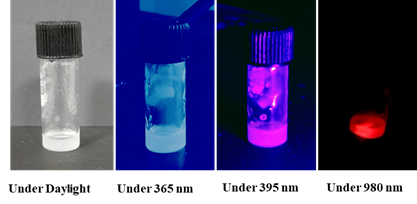New Delhi, October 30, 2024: A novel ink with enhanced security features have been developed with luminescent nanomaterials can help stop counterfeiting in currency, certificates, branded goods and medicines, official sources said today.
Counterfeiting is a growing problem worldwide and researchers are trying to find unique ways to prevent it.
Luminescent properties of rare earth ions and the characteristic emissions of bismuth have long been known.
Scientists at the Institute of Nano Science and Technology (INST), an autonomous institute of Department of Science and Technology, have used this property of rare earth materials, to synthesis a first of its kind security ink based on luminescent nanomaterials with rare earth doping, enabling excitation dependent luminescence (Under both UV and NIR light it gives Visible emission).
The ink can overcome the limitations of current covert tags, which are security features usually visible only under UV light and can be easily duplicated.
The new ink offers enhanced security features through its ability to display different colours under various light wavelengths.
Specifically, the ink appears vibrant blue under 365 nm light, pink under 395 nm light, and orange-red under 980 nm near-infrared (NIR) light and remains effective under a range of light, temperature, and humidity conditions.

The luminescent nanomaterial was synthesised using a simple co-precipitation method at 120°C. After synthesis, the nanomaterials were dispersed into commercially available PVC ink using sonication (process of dispersing nanoparticles into solvent by applying sound energy).
This mixture was then used to create patterns and letters through a screen-printing technique. These printed patterns, when exposed to different wavelengths of light, clearly showed the desired colour changes, proving the effectiveness of the ink.
By combining rare earth ions with well-known luminescent properties and bismuth with characteristic emissions the team was able to enhance the encryption and decryption capabilities of the ink, improving its security potential.
The luminescent ink made from these nanomaterials has significant potential to combat counterfeiting. It can be applied to fake-proof various items, including currency, certificates, medicines, and branded products.
This allows both consumers and manufacturers to easily verify the authenticity of their items, providing a simple yet powerful tool to detect counterfeits.
More Stories
Attack on Senior PR Dept Official in Office; people condemned the incident
In a serious incident, couple of people today attacked a senior Public Relations official of the Chhattisgarh Government when he was performing his duty at Samvad.
Sushma Sawant New Principal Secretary Law of Chhattisgarh
Chhattisgarh Government today appointed Sushma Sawant as the new Principal Secretary Law and Legislative Affairs.
Farmer registration on Agristack portal mandatory for paddy procurement; Registration open till October 31
Chhattisgarh government today clarified that registration on the Agristack portal is mandatory for farmers to purchase paddy at the support price in the Kharif marketing year 2025-26.
3-Day programme in districts on Chhattisgarh Foundation Day; With theme of 25 Years of Development Journey
The Chhattisgarh government has decided to organise three-day programmes in all district headquarters on the occasion of Silver Jubilee function of the Chhattisgarh Foundation Day, similar to last year.
Chief Minister Sai discusses ISRO scientists to enhance Chhattisgarh’s participation in ISRO’s journey
Chhattisgarh Chief Minister Vishnu Dev Sai said today that his government is encouraging innovation and technical education so that the state’s youth can develop an interest in space science and actively participate in the country’s space missions.
Workshop to ensure responsible digital governance and effective content management
The Ministry of Electronics and Information Technology (MeitY) today organised a workshop on Management of Information on Intermediary Platforms at New Delhi to sensitise participants on key provisions of the IT Act, 2000, and IT Rules, 2021, particularly Sections 69A and 79(3)(b), and Rule 3(1)(d), and to promote a clear understanding of their application in ensuring responsible digital governance and effective content management.


